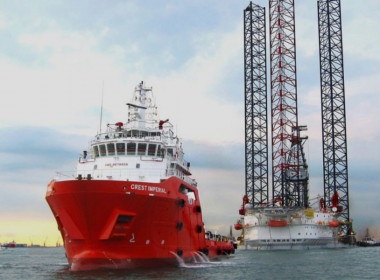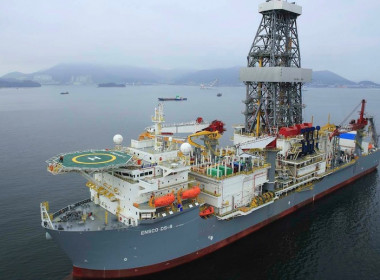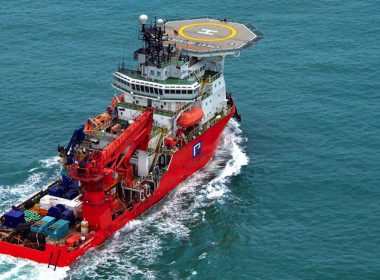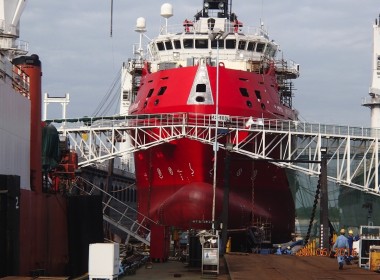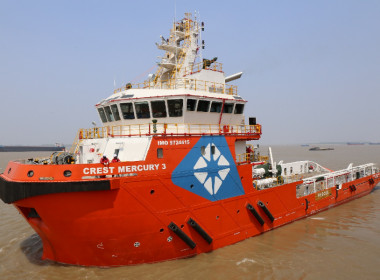COLUMN | No Saint’s Day: Pacific Radiance and ENAV, Keppel and Dolphin, Fisher’s blow-up [Offshore Accounts]

After the horror of Halloween comes the calm of All Saints’ Day, November 1, when the Catholic church commemorates all those saints, both known and unknown, who have attained heaven.
As you can imagine, there are few saints in the offshore industry (as we saw last week here), but several companies are at least clambering out of hellish situations in Singapore.
If you’re into operations or maritime technology, this week’s column isn’t for you. But if financial engineering and how to turn around a zombie company and take control of a distressed asset perfectly legally in Singapore is of interest, then the All Saints’ Day tale of the Pang family and Pacific Radiance will enchant.
Cursed companies stagger on as zombies
It has taken seven long years to sort out the debt and distress that Singapore’s offshore companies inflicted on themselves in the go-go boom years. The downturn since late 2014 left nearly every offshore owner in Singapore in default. This number included KS Energy, Swissco, Otto Marine, Swiber, Ezion, MEO, Emas Offshore and Pacific Radiance. Together, from all sources the Singapore universe of listed offshore and drilling companies had borrowed more than US$5 billion by 2016 (here).
Privately owned Pacific Richfield Marine, owned by Indonesian entrepreneur Ronnie Sujaca, was an early casualty of the downturn and its fleet was liquidated. Otto Marine was also subject to compulsory liquidation. Swissco’s fleet was purchased by Allianz Marine of the UAE in 2019. POSH was delisted from the Singapore stock exchange and taken private by the Kwok Group in 2019 (here). Kris Wiluan’s rig owning company KS Energy was placed under judicial management in 2020, and he was convicted in August of this year of market rigging for trying to support the company’s share price (here). More tricks than treats from Mr Wiluan, who was charged with 112 counts of criminal activity.
Lion City lenders make penance, find peace
It can be said 2021 has been the year that the Singapore banks finally budged on their insistence that they be repaid in full on the estimated US$2 billion or more that they had lent to the City State’s failing offshore support vessel (OSV) owners, offshore construction and rig companies. Instead of kicking the can down the road and extending judicial management, the big banks started to swap their debt for shares in equity and to write off loans to enable them to sell companies and exit their position. DBS set up a subsidiary called Rising Phoenix to take over MEO from Champ and Headland, the two private equity players that had led it into bankruptcy (here). MEO’s debts were wiped off and the bank began touting the company for sale as a going concern.
In September, we reported here that Britoil was being restructured by its main lenders as the interests behind X-Press Feeders container lines took the fleet of some twenty anchor handling tugs over and paid down the Singapore bank debt at a discount, in conjunction with Spanish logistics specialist Perez y Cia, and the company’s founder and former owner, David Hill.
Pacific Radiance/ENAV is on
In July, we covered here how Pacific Radiance was in the process of selling its entire fleet to Mexican-American investment company/owner ENAV. On October 28, the deal moved further ahead, as announced to the Singapore Stock Exchange here.
In the Hellraiser horror franchise, when someone solves a complex antique puzzle box, the click of completion unleashes demonic forces that try to kill the holder. Pacific Radiance’s lenders and bondholders are currently feeling similar pain, albeit not from fiendish torments from across a supernatural portal.
Pacific Radiance’s debt restructuring is a complicated and unusual transaction, with the Pang family, which founded Pacific Radiance and control its management, at the heart of it, as usual. ENAV will pay US$200 million to Pacific Radiance’s lenders (headed by Singapore’s state-owned DBS Bank) for its fleet of 33 OSVs. The banks accept this payment as full and final write-off of the loans secured on the vessels.
Asset-light is the new future
The sale of all the ships means Pacific Radiance will become a ship manager to ENAV. In future, Pacific Radiance will be an asset-light company responsible for marketing, crewing and operating its former ships in Asia and the Middle East.
Braemar ACM provides the value
The US$200 million valuation was based on an “as is, charter-free” valuation of US$105.6 million given by independent British ship broker Braemar ACM in May, plus the value of the charters that the working Pacific Radiance fleet holds.
This US$105 million valuation from Braemar ACM compared to the book value of the vessels in Pacific Radiance’s own accounts of US$232 million shows how even after years of impairments and asset write-downs, the actual value of offshore ships is well below the newbuild prices of the boom year less depreciation.
TINA – There Is No Alternative
Once again, the board of Pacific Radiance made it clear that, in the words of Margaret Thatcher, that, “there is no alternative” for the banks and for the shareholders for the ENAV deal:
“Without the Debt Restructuring Plan, the [Pacific Radiance] group is likely to face liquidation and prospects for recovery for unsecured creditors and shareholders will be practically nil. The group has already carried out extensive investor searches and undertaken concerted negotiations with a number of them in the past few years, and given the uncertain external conditions exacerbated by the COVID-19 pandemic, it is not likely that an alternative proposal from the current one offered by ENAV will emerge in the near future.”
Given that Pacific Radiance and its subsidiaries owed US$472 million of debt before the transaction with ENAV, the “TINA assessment” is correct.
The noteholders become shareholders and Perpetual holders
But the removal of the bank debt alone doesn’t quite make Pacific Radiance a viable business, and so a further restructuring is foreseen to resolve the issue of the unpaid bonds. The noteholders are fobbed off with 1.8 billion (with a “b”) new shares in the company, in return for wiping out their debt, and receiving a new Perpetual security valued at SG$3 million (US$2.22 million), which entitles them to up to a 2.5 per cent return on the face value of the Perpetual to be paid out if Pacific Radiance has both positive cash flow and more than SG$5 million (US$3.71 million) in its bank accounts. If it is not generating cash, or if it doesn’t have the SG$5 million on hand, then the holders of the Perpetuals do not have to be paid, and the company never has to redeem the face value of their debt either.
Mr Pang’s salary may be deferred
However, if the company is tardy to repay the Perpetuals, then the former bondholders do have one stick with which to beat the Pacific Radiance management, an unusual provision that withholds the salary of the Pang family members working for the company:
“The Pacific Radiance Key Management have undertaken with Pacific Radiance that the salary due to them in respect of their employment with Pacific Radiance will be deferred until such time that the Issuer redeems the Perpetual Securities” in tranches of SG$1 million per year (US$740,000).
This may seem like a punitive sanction, but, of course, there could be other ways that the Pangs could take money out of the business. Like dividends.
Who emerges on top when the rump business is restructured? You don’t have to think very hard about that one…
The winner takes it, the loser takes a fall
The Pang family! Who would have guessed?
“The Management Shares will represent approximately 253 per cent of the Existing Share Capital and approximately 40 per cent of the Enlarged Share Capital. Including the 490,073,444 existing shares held by the Pacific Radiance Key Management, the shareholding of the PRL Key Management will be approximately 51 per cent of the Enlarged Share Capital.
“The Pacific Radiance Key Management will subscribe for the 1,808,543,200 Management Shares (before the Proposed Share Consolidation) for cash in the aggregate amount of SG$1 million or 0.06 Singapore cents per share,” said the announcement. Fifty-one per cent of the shares will give the trio of Pang family directors and acting executives control of the newly restructured Pacific Radiance. The banks managed to negotiate a four per cent on top of the cash they received for the sale of the vessels. For less than one million US dollars the noteholder and other shareholders give control of the company back to the Pang family, whose debt-fueled expansion got the company into the mess it has found itself since 2018 when its shares were suspended on the stock exchange.
Of course, this wasn’t something they saw or planned, the company claims, but was forced upon the other shareholders by ENAV: “To give ENAV the assurance of management continuity, the company proposes to issue the Management Shares to the Pacific Radiance Key Management such that the shareholding of PRL Key Management will represent approximately 51 per cent of the Enlarged Share Capital of the company…”
Power to the patriarchy
What’s perhaps most insulting/unusual/interesting (delete as applicable, or insert your own adjective) about the whole arrangement is the division of the shares amongst the Pang family themselves. The patriarch Pang Yoke Min takes the lion’s share, and leaves his sons, one of whom is the acting CEO of the company, and the other the acting CCO, holding about one thousandth of the shares he himself holds.
Yes, more than 99.9 per cent of the Pang family shares go to Pang Yoke Min himself, as this table in the release shows:

The justification for the wholesale transfer of control in the restructured company is interesting to say the least.
“The issue price of the Management Shares takes into account the negative Net Tangible Assets and the general corporate and working capital requirements of the Company after completion of the Debt Restructuring Plan,” the release stated.
So, the company is not worth anything, so the control can be given to the management for a pittance?
This might lead the other shareholders, who are massively diluted by the management share issue, to ask who was running the company when it borrowed US$472 million and became insolvent. Indeed, Pacific Radiance was still paying the Pang trio hundreds of thousands of dollars every year through the period when the company was in default.
Whilst they took pay cuts, as we noted here, they weren’t exactly made destitute by the financial problems Pacific Radiance faced. The directors and key management personnel in Pacific Radiance were paid US$1.3 million in total in 2020 and US$1.7 million in 2019, according to the annual report (here).
Proceeds of Management Shares used to pay Perpetuals, so Pang salaries are also paid
The next clause then basically says that by paying the SG$1 million for their management shares, the Pang family will then use the cash they give the company to make the first payment on the Perpetuals, thus guaranteeing that they continue to receive their salaries:
“The company expects to utilise the proceeds from the PRL Key Management relating to the Proposed Share Issuance to Management in the following manner: (a) approximately 50 per cent to be used for repayment of the amounts outstanding under the Perpetual Securities; and (b) approximately 50 per cent to be used for general corporate and working capital purposes.”
So, the Pangs pay for shares that give them control of the company and then Pacific Radiance uses the proceeds of the share sale to ensure that the Pangs also receive their management salaries. The stick of salary retention is barely a fig leaf, let alone a stick.
The management and the existing shareholders also get warrants entitling them to buy additional shares in the company. Again, the capital raised will be used to pay back the Perpetuals and ensure that the next tranche of salary is paid to the Pangs.
Both sides of the table
Clearing Pacific Radiance’s debt and raising new capital through the warrants and management share issue radically transform the company’s balance sheet.
Today, Pacific Radiance has negative equity of US$290 million, its board estimates. When the interlocked transactions are completed, it will have positive shareholder capital of US$27 million and tangible assets of 6 US cents per share. The Pang family will control 51 per cent of the shares in the restructured group.
It will also have a business that is completely dependent on one customer – ENAV, the owner of the 33 vessels that Pacific Radiance will manage. And who will be sitting on the board of ENAV, on the other side of the table?
That would be, the Pang family. Again.
The announcement reminds us that the Pangs have “committed to co-invest in the Purchaser [of the Pacific Radiance fleet], by subscribing for a minority equity interest not exceeding 15 per cent of the Purchaser’s share capital.”
So, a 15 per cent Pang family-owned entity will own the former Pacific Radiance fleet and will be the main customer of the new Pacific Radiance ship management company, which will be 51 per cent controlled by the Pang family.
What could possibly go wrong for the minority shareholders in the new, improved Pacific Radiance, and for the other shareholders in ENAV?
Horror show at Keppel
If the Pangs have solved the puzzle box of Pacific Radiance’s debt and managed to maintain control of the company themselves and get a board seat in ENAV, we can only admire the deftness with which they have played their hand.
Events at Keppel suggest that CEO Chin Hua Loh might take a playbook out of their account before his credibility is shredded like one of the victims in Hellraiser. The last week has been a horror show for Singapore’s biggest rig builder, even as its compatriot SembMarine also plunges from crisis to crisis as well as the two prepare to consider merging their offshore fabrication yards.
US investor alleges collusion in fraud
Firstly, there was a US$820 million law suit filed against it in the USA. You can read The Business Times coverage here. Investment funds managed by EIG Management Company are suing Keppel in New York, alleging that the company was “aiding and abetting fraud”, carried out by Sete Brasil Participacoes, the spectacularly corrupt, and now spectacularly bankrupt, Brazilian rig-building scam, which we covered here.
Try as it might, Keppel cannot seem to break free of the shackles of its past.
The company says that EIG’s case is groundless and that it does not expect to have to pay out the claim in any future summary judgement. It says it will vigorously defend itself. In 2020, Keppel successfully had EIG’s earlier claim under the Racketeer Influenced and Corrupt Organizations Act thrown out (here).
Rig woes for Borr continue as Seadrill emerges stronger
We noted in February (here) that despite claiming it is exiting the rig building and rig owning business (which it entered when customers for whom it was building rigs went bust, leaving the rigs with Keppel), Keppel is not really anywhere near exiting the rig owning business.
Firstly, the pressure on Keppel’s key customer Borr Drilling increased when Seadrill announced last week that it had secured lender consent to exit bankruptcy, shorn of its debt with a much stronger balance sheet (Reuters coverage here).
Under the plan, Seadrill’s creditors will exchange US$4.9 billion in debt for equity in the company and Seadrill will also raise US$350 million in new financing. With a fleet of 12 modern international jackups, and additional harsh environment jackups, Seadrill is a formidable competitor to Borr. Keppel needs Borr to pay it around US$700 million for rigs that are nearly completed in its Singapore yard, but for which Borr has deferred delivery again and again (here).
We do not see how Keppel is not going to be adversely impacted if Borr has to restructure. Seadrill’s successful restructuring only increases the pressure on Borr, and by definition, on Keppel.
Dolphin Drilling takes over the marketing
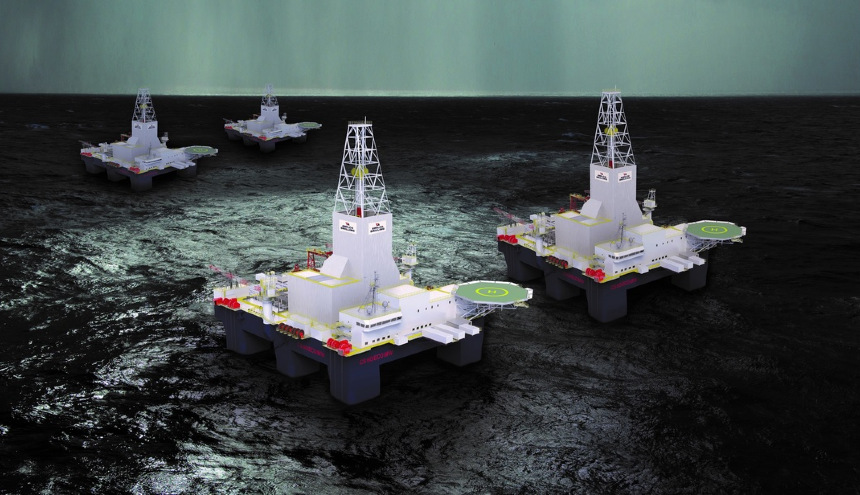
In 2020, Keppel and Norwegian harsh environment rig owner Awilco went to arbitration over the cancellation of two Moss Maritime CS60 Eco MW design semi-subs for the North Sea, which Awilco had ordered for US$425 million each, and had provisionally named Nordic Spring and Nordic Winter. In June 2020, Keppel terminated the first newbuild contract with the rig company, and in December, Awilco terminated the second, and the two companies slung claims and counterclaims over who owed what. That arbitration has not finished.
Now further developments suggest that Keppel will once again end up owning the units for far long than it hoped. The company has announced that it will be allowing Dolphin Drilling to market the units on its behalf.
But Keppel gets no cash now
This is great, except that clearly Dolphin is not buying the units, simply taking a risk-free position to market them in the North Sea. Private equity company SVP Global bought Dolphin by buying all its debt for a discount in 2019 after the Fred Olsen affiliate went bust out. This is part of the great private equity expansion into distressed assets offshore in the long downturn (here).
Dolphin de-listed from the Oslo stock exchange and established itself in Aberdeen with a new management team led by Bjornar Iversen, the former CEO of Songa Offshore. Whilst it is debt free, Dolphin is a very niche player and currently owns only three semi-subs. I do not see it buying the Keppel rigs in the short term, given the high book value at which Keppel holds them.
The “opportunistic marketing” of distressed rigs is now a feature of the drilling industry, as operators with know how to represent owners like Keppel, who have been stuck with distressed rigs.
Saipem bareboated a drillship from Samsung in Korea (here). Aquadrill (the former Seadrill Partners now owned by its creditors) has appointed Diamond Offshore Drilling, Energy Drilling, Odfjell Drilling, and Vantage Drilling to market and manage its fleet, whilst Odfjell has also been working successfully with CIMC Raffles to market the Chinese yard’s harsh environment rigs.
The evidence suggests that even as the rig market improves, Keppel is going to be holding the rigs it says it doesn’t want to own for a lot longer than its shareholder may be expecting.
Keppel’s “ghost” rig fleet needs exorcising.
James Fisher and Sons issues profit warning
October 25 saw a complete rout of shares in James Fisher and Sons following a trading update (here) where the company admitted its profits for the year would fall far short of previous expectations. Everything that could go wrong does seem to have gone wrong. Fisher reported that “a recent deterioration in the condition of a financially distressed customer has increased bad debt risk” by just under US$3 million. An attempt to resolve a defence contract worth just under US$3 million has also stalled, and CEO Eighan O’Lionard is “no longer forecasting a resolution in 2021.”
You will recall that in January 2020 we warned that there might be “something fishy at Fisher” (here). Then the share price was 2,020 pence. On Friday October 29, the shares closed at 409 pence (US$5.59) each. The CFO has resigned, large hits have been taken on the company’s dive support vessels, and one has been sold.
When we commented in September that “the wheels on the bus” were falling off at Fisher (here), we noted that, as a gesture of confidence in the company, the chairman, chief executive, and the new CFO had invested around US$60,000 each to buy five thousand Fisher shares at around 860 pence (US$11.80) each. Their investments have now halved in less than seven weeks.
I guess it could have been worse. They could have invested in another company we have been covering: subsea miner The Metals Company (formerly DeepGreen), which has now lost over 70 per cent of its value as shares plunged to US$2.89 on Friday after a key investor disappeared without paying in the capital he had promised (here).
If in September the wheels on the bus were falling off, it now looks like Fisher’s engine has blown up. Quite why the trustees of the charitable trust that holds a significant interest in the company chose to increase their investment in the company earlier this year is not clear. They have destroyed yet more value for the trust, which is supposed to provide funds for projects in and around Fisher’s headquarters in the UK in Barrow in Furness. Pouring money into this train wreck is not in the long-term interests of the trust.
Fisher’s rampant acquisition strategy is falling around its head. O’Lionard has now decided to “simplify the business” and sell off “non-core assets and activities” to – wait for it – “strengthen the balance sheet.”
This will prove extremely difficult, as we foresaw in 2020, because so much of James Fisher’s balance sheet is in the form of “goodwill,” an intangible item relating to its previous decade-long spree of buying other companies for much more than their underlying assets were valued in their accounts.
With his ancestry, O’Lionard will recall that Halloween mirrors the great Celtic festival of Samhain, where bonfires are lit on hilltops across Ireland and Scotland to protect and cleanse. Unfortunately, the only bonfire he seems to be lighting are under the Fisher balance sheet.
Shareholders should consider how they can protect and cleanse themselves against the rapidly deteriorating situation at Fisher.
Background Reading
For more information on the Cenobites, the merciless torturers of the Hellraiser films, see here.
For the merciless torture of companies which borrowed too much money, see Credit Suisse’s analysis of the situation in 2016 here.


